Steve Jones on John William Inchbold’s Suggestive Study, Paradise (Head of a Girl and a Bird of Paradise) 1864–5
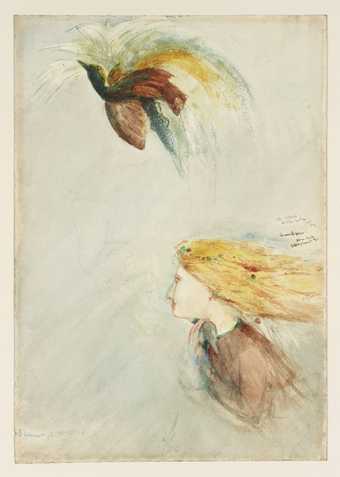
John William Inchbold
Suggestive Study, Paradise (Head of a Girl and a Bird of Paradise)
(1864–5)
Tate
As a geneticist, my job is to make sex boring. Artists attempt the opposite: to add romance to the prosaic rules of biology. Darwin wrote: ‘The sight of a feather in a peacock’s tail, whenever I gaze at it, makes me feel sick.’ Why did only males have one and why was it so clumsy? How could natural selection – inherited differences in the ability to reproduce – do that? Selection, he saw, was a two-part exam. The first paper, survival, was simple, but the second – reproduction – was more subtle.
Any attribute of one gender favoured by the other (‘beauty’, as we call it) would become common, however absurd it appeared and however much, within limits, it reduced the chances of staying alive. Sexual selection explained many of the joys of nature – flowers, birdsong and baboons’ bottoms included. Darwin also claimed: ‘Of all the causes which have led to the differences in external appearance between the races of man… sexual selection has been by far the most important.’
Inchbold’s painting is in that tradition: the blonde as the human Bird of Paradise; the highest and most beauteous form of all. Unfortunately, Darwin was wrong. Blondes emerged only 5,000 years ago when farming spread to north-west Europe. The combination of lousy weather and a dismal diet led to a shortage of vitamin D, and to rickets. Those with the lightest skins (and hair) were favoured because sunlight could get in and make the missing substance: hence the flaxen-haired subject. Head of a Girl and a Plate of Muesli would not, perhaps, have the same impact.
Suggestive Study, Paradise (Head of a Girl and a Bird of Paradise) was purchased as part of the OppéCollection with assistance from the National Lottery through the Heritage Lottery Fund in 1996 and is included in ‘Endless Forms; Charles Darwin, Natural Science and the Visual Arts’ at the Fitzwilliam Museum, Cambridge, 16 June – 4 October.
William Fiennes on The Cholmondeley Ladies British School, c.1600–10
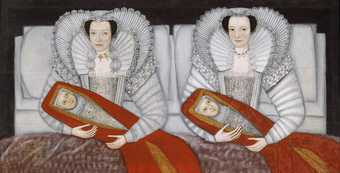
Unknown artist, Britain
The Cholmondeley Ladies
(c.1600–10)
Tate
My ruff was a sort of amphitheatre of lace and bone that screened off large sectors of the world: I could only see what lay ahead, as if I were a language with no past or present tenses. The artist (I never learned his name) kept stepping away, frowning as he looked from me and my sister to his version of us on the wide board and back again, as if confused by the quantity of women in the room, our original doubling now redoubled in his painting. All this time my boy was quiet and still, even as I wished for him to shout or scream and so be the disruption of which I was myself no longer capable. I thought about the little gasp he’d given that morning when he saw our church’s spire narrowing above him into the blue, and of how, when they used both hands to pull the cords of my corset tighter, my maids were like mariners rigging a ship, hoisting the sails: it helped to think of some part of myself unfurling even as the servants hemmed me in. I’d noticed, as they arranged us against the pillows, her necklace, intricate with pendants, and been grateful for my simple carcanet of garnets and pearls. I felt the weight of my child in my hands and the cool lightness of metals and stones on my bare skin. I heard my sister breathing.
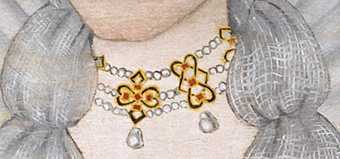
Seventeenth-century British School
The Cholmondeley Ladies c. 1600–10
Oil on wood
107.4 x 191.4 cm
© Tate
We would wait a long time for men to give the word and release us to our separate chambers.
The Cholmondeley Ladies was presented anonymously in 1955 and is on display at Tate Britain.
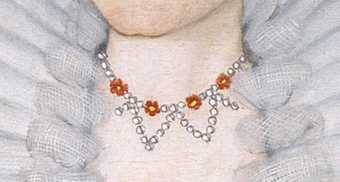
Seventeenth-century British School
The Cholmondeley Ladies c. 1600–10
Oil on wood
107.4 x 191.4 cm
© Tate
Valentine Warner on Charles Collins’s Lobster on a Delft Dish 1738
I love lobsters. They are worriers and I empathise with their grumpy but harmless nature. However, they are delicious to eat…
Lobster Mojo de Ajo (serves 2–4)
1 x 900g live lobster
For the mojo de ajo sauce
1 generous head garlic
roughly 100ml light olive oil
2 plump chipotle chillies, finely chopped
1 large lime, freshly squeezed
½ tsp flaked sea salt
fresh coriander leaves, to garnish
lime wedges, to serve
First peel all the garlic cloves and chop to medium fine. Put in a small pan and cover with sunflower oil. Bring the oil up to a gentlest simmer and set the heat, allowing the little lemonade lines of tiny bubbles to fizz from the garlic. Do not overheat or boil at any cost or the garlic will burn. Scientific attention is needed. The garlic is ready when it begins to turn an old ivory colour. This will take ten to fifteen minutes. At this point drop in the finely chopped chipotles, the squeezed lime juice and the salt. Thirty seconds after adding these turn off the heat and allow the mixture to stand for at least three hours.
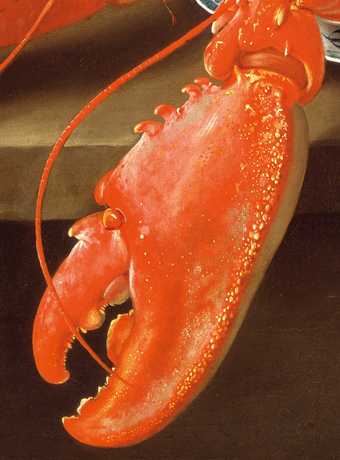
Charles Collins
Lobster on a Delft Dish 1738
Oil on canvas
70.5 x 91 cm
© Tate
To cook the lobster, light the barbecue and leave to burn until a light dusting of grey ash covers the coals. (You can also cook the lobster under the grill for four minutes on each side.) Do not remove the bands from the lobster’s claws until you have killed it, as this will only result in severed fingers on the kitchen floor. When killing your dinner do it swiftly, as squeamish scrapings on the shell with a knife will only distress the lobster. Lay the lobster flat on a board and hold it down firmly with a cloth to prevent it arching up. Picking up a large heavy knife, deftly and without hesitation drive the point into the middle of its head and on to the board. Lever the blade down to cut between the eyes. Turn it round. Put the blade back into where you made the first entry and cut the other way straight down and through the middle of the tail section. Remove the green parts inside the lobster’s head and throw away with the snipped off elastic bands. Taking a rolling pin, crack the claws without pulverising them and leaving the shell on. Brush the tail meat generously with the garlic oil, but not the tasty sediment in the bottom. Salt lightly. Put the lobster on the barbecue, flesh side down. Cook for four minutes before turning on to the shell side and cooking until it has all turned vibrant red (approximately another four minutes). Lift off the rack, and put on a serving plate. Spoon over the sauce liberally, ensuring you get lots of garlic and chilli from the bottom and less oil. Garnish the empty head cavity with coriander and lime wedges for squeezing. Serve with cold beer.
Lobster on a Delft Dish was purchased in 1988.
Carol Bove on Daria Martin’s In the Palace 2000
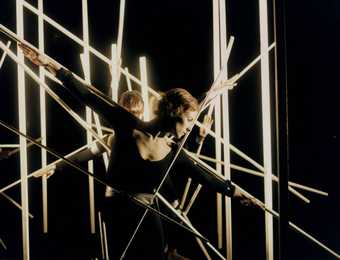
Daria Martin
In the Palace
(2000)
Tate
I first met Daria shortly after I had seen and fallen in love with her film Birds. I had been at the New York opening of her first exhibition there. Despite a well-attended evening, when I spotted her she was leaning against the wall on her own. I was too shy and insecure to compliment her on the piece, which seems crazy now.
When we met a few years later in London we spoke briefly about growing up in the San Francisco Bay area. We must have been talking about the human potential of movements, or cults, or whatever other forces guided the energies of Californiaseekers in those days. This led to her description of a dance class she had recently attended called “Body Weather”. I wish I could steal that name. Body weather. It expresses a condensation of everything that dance is and what the body could mean in performance art. Both New Age and also drab and materialist; Gaia, the mother goddess and body of the earth, plus pure pragmatism. The integration of one’s self with the environment and receptivity to changing forces. A spiritual practice that seeks to develop an accurate picture of the present physical moment. Experience. A figure in a landscape.
What could they possibly have done in such a class? I think she had been disappointed by it. I can’t remember. As I recall, and my memory of her description is vague, the participants were instructed to stand face to face with the other people and talk about the body and about the weather.
The instructor demonstrated the action using the mannerisms and affectations of Brecht-style performance, but softened and modified by a hard-core meditator’s sensibility. And? I think the conversation took us someplace else, or stopped abruptly at that point.
We only ever met once or twice more in passing or at an opening, but I have a special affection for her work since I’ve been a witness from the beginning. And I always think about it through the lens of “Body Weather”.
In the Palace was purchased in 2000.
